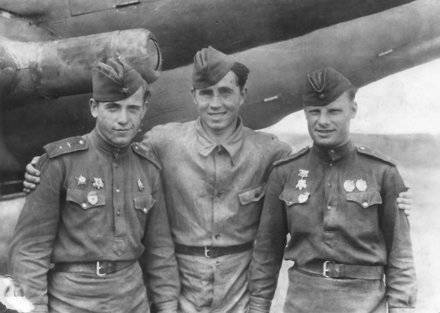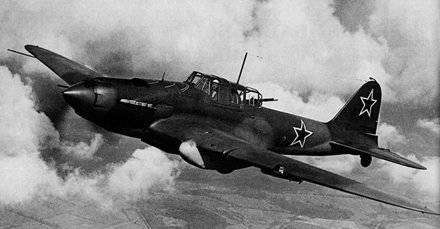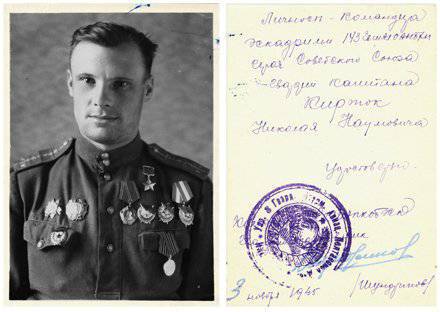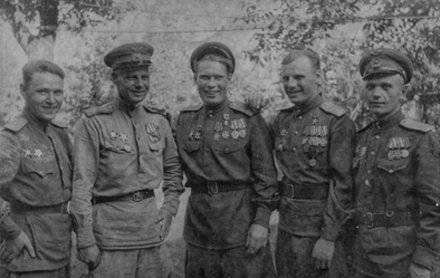Mystery of two heroes

A long conversation came to an end when the veteran took out a photo album. Talking about the people in the pictures, he called Ivan Drachenko among others.
The veteran asked: “This is the very pilot who lost his eye but returned to Aviation and became not only a Hero of the Soviet Union, but also a full holder of the Order of Glory? ”
Nikolai Naumovich answered in the affirmative. He said this:
- When Ivan returned to the regiment after the hospital, in the very first conversation he revealed his secret to me. At first I did not believe it, but when I saw the prosthesis, I asked: “How will you fly?” And then he told about what he had gone through and changed his mind in captivity. Ivan turned to me with a request to take the slave to himself: “Nikolai, I must fight. I have a huge bill to the enemy. And not only for the deceased father or his injury. I for those who did not survive in the camp and could not escape, I need revenge ... ”I promised to keep my friend’s secret and help him in every way.
He read Drachenko's book “On the wings of courage”, but the names mentioned in it were erased in memory, and therefore, when he returned, he took it from the shelf. The author wrote about Nikolai Naumovich on one of the first pages: “Nikolay Kirtok and I went up the jagged steps of the Reichstag, between columns, somewhat resembling ridges of long-extinct dinosaurs. Everywhere traces of bullets and deep strokes of the fragments. Dust crunching unpleasantly on the teeth of heavy stone mist, slowly settling on the chaotic jumble of debris. Columns in a continuous tie of inscriptions. They wrote to everyone that fell under their hands: in ink, chalk, pencils, coal, knife blades, bayonets ... Exchanging a glance with Nicholas, they also left their signatures on the gray granite of one of the columns. ”
... Senior pilot of the 140 Guards assault aviation regiment of the guard Junior Lieutenant Drachenko on the Kursk Bulge made a 21 combat sortie, destroyed three tanks, 20 vehicles with ammunition and enemy manpower, 4 anti-aircraft guns, ammunition depot, to the company of soldiers. Awarded the Order of the Red Star.
He was shot down by 14 August 1943, in the Kharkov region. Three six Ilov received the task: to strike at the tank column. On the approach to the railway station of Meref, attack aircraft fell under heavy fire of anti-aircraft guns. But suddenly it stopped: a dozen two Me-109 slipped out from behind the clouds. On that ill-starred day, the enemy shot down an 14 aircraft. Not survived and Drachenko. Here's how about this in the book: “The explosion shook the car. He glanced at the dashboard - and who walked like a hammer over it. The attacker was losing weight with every second, and it became increasingly difficult to control it. Height inexorably fell. The horseshoe-shaped positions of anti-aircraft installations, machine-gun nests, and rows of trenches braided by a network of wire barriers were already clearly visible. The Germans were rushing along the road. We must pull away from them, closer to the ravine. And suddenly there was a deafening crash, it felt like the car crashed into some invisible wall. An incredible force tore me from the seat, it seemed that I was falling somewhere, like in a bottomless well. And there was no end to this fall ... When the consciousness returned, it was as if in a fog I saw gray-green figures, heard someone else speak.
Captivity ... This thought struck, tied hands, bound the will. ”

So the pilot was at the enemy. For several days I lay in a stuffy barrack, through the walls of which penetrated the cries of the guards, the growls of sheep-dogs, the moans of the beaten, shots. Then, along with others, they began to drive him to work - they dug a foundation pit. Some dug, others immediately threw him. And so from morning till dark ...
One day he had a conversation with a German colonel. “While you were with us,” he began without any introduction, “we learned everything. You are an attack pilot. And attack planes, as far as I know, are brave people. Do not put your finger in their mouths. And the cars you have - devils. Schwartz Tod.
However, our anti-aircraft gunners are also good ... bang-bang-and you are our guest ... "
Unexpectedly, everything changed for the pilot: a separate chamber, a bed with clean sheets and a soft blanket, a fresh headband, and a neighbor from the other chamber, introduced by a tanker officer, frequent the ward. From him, Drachenko has found out: the Germans began to experience a shortage of flight personnel and, according to Hitler's orders, they are trying to gather prisoners of pilots into special camps in order to use them on their side under the flag of “Russian aviation”. A neighbor persuaded: "You will agree - you will live with chic." He showed magazines, where in the pictures Vlasovites tasted “earthly delights”. A German colonel came to the ward: “Here is a document, sign it - and in your life everything will change at once. You get freedom and a new beautiful car. You will fly with our best aces and, like them, will receive Reichsmarks. Many, many brands. And you will have women - beautiful, affectionate ... "
But all attempts to lure the Soviet ace were unsuccessful. And when once again he resolutely said: “No!”, He was given an injection, put to sleep and cut out his right eye. The enemies hoped that the Soviet pilot would never rise into the air again.
Our troops were rapidly advancing, and the Nazis were in a hurry to get out of Poltava. On September night, the prisoners were loaded into covered cars and taken to Kremenchug. It was known about that camp that in the winter thousands of prisoners of war froze and became cripples. In the same place in the barracks, to the limit of people crowded, many-tiered bunks collapsed, and more than three hundred people died.
Everyone understood that this is the last path. Drachenko and another pilot on the road strangled a convoy sitting in the back. Five people managed to jump on the go. Hungry, emaciated, with inflamed wounds, they walked at night to the east, being guided by the misty scattering of stars. They were picked up by the scouts.
In the hospital, Ivan Drachenko cured and inserted a prosthesis. In the mirror, he saw that there was no difference between the eyes, only the eyelid was slightly lowered over the right one.
“But what next? Even in the infantry with one eye do not take. Even to go, to pick up some object becomes difficult. But how to fly, where the eye is the main control "device"? As they say, and in the wagon train ordered. Only one road - to the rear ... "
These thoughts did not give rest to the pilot. And when Professor Sverdlov said: “Everything, young man. Your summer career is over, and you need to put up with it ... ", began to beg:" But I am healthy. I see you from all angles, read the table from the top to the bottom line. You are simply mistaken, professor, making such a conclusion! Please write a certificate in which it would appear that such and such a pilot is sent to his unit for further service. I promise you that I will be anyone: a mechanic, a parachute handler, an armed man. I even agree to bring water and firewood to the kitchen, just let it go to the part. ”
And ... he persuaded the professor: the certificate did not say anything about the absence of an eye: "Junior Lieutenant Drachenko? And. G. is sent to his unit for further service. " Although at parting, the doctor said: “But bear in mind - do not approach the aircraft ...”
The pilot returned to his native regiment in March, 1944.

I ask Nikolay Naumovich: “Why did Drachenko address you?”
- We both graduated from the Tambov military school of pilots, together began to fly on the “humpback”, as they called IL-2, and after graduation from the junior lieutenants got into the air regiment, which fought on the Kursk Bulge. By the time Ivan returned to the regiment, I had to put many young pilots on the wing, so there was experience in such work. But the main thing, perhaps, is that we were bound by kind, sincere relations. And I did everything to regain his lost skills. True, he warned that if the arrows get to know about the lost eye, then hardly anyone agrees to fly with him. Worked hard, and I really saw that every day the machine becomes more obedient to him. At first we had such a tactic, for example, which is far from clear to everyone. When Drachenko sat down, I went to the landing "T" and conducted it by landing. Some were perplexed, others sympathetically sympathized: the man, they say, only from the hospital, forgot the piloting technique. With Ivan, we organized brutal "fights" to prove superiority in piloting aircraft, trying to get into each other's tail. And it was not just the satisfaction of some of our eccentricities. The benefits are obvious: instant action, the reaction helped us more than once in critical moments of a real battle. Later, Ivan and I worked out such a difficult maneuver as “scissors”. The essence of it was this: a pair of attack aircraft, running a little towards each other — leading slightly higher than the slave — began to change places. For example, if the slave is going to the right from the back, then he would move from the bottom to the left, and leading from top to bottom. Then again, but in reverse order. And since the maneuver was carried out with a roll, both attack aircraft all the time saw the tails of each other and reliably covered them. And all this at low altitude.
True, as Kiertok noted, Drachenko was difficult without an eye, and therefore in flight he often opened a flashlight. Comrades advised not to be brave. But the matter was not courage: he saw better with an open lamp. “And over time, Ivan became our best air scout. He knew the whole front. And the attack was great. The regimental commander sent him to the most difficult tasks. ”
... 6 April 1944 of the year during the departure for reconnaissance Drachenko was attacked by 5 fighter jets FW-190, but on a heavily damaged aircraft managed to reach the airfield and land. For the valuable intelligence brought, he was awarded the Order of Glory of the 3 degree.
26 June 1944, junior lieutenant Drachenko, flew the head of the pair to explore the area of Yass. When performing a combat mission, he engaged in battle with German fighters and repulsed all their attacks. Then he attacked a train at the Tuzir railway station and returned to his airfield with intelligence. Awarded the Order of Glory 2-th degree.
October 7 1944 of the year for 55 successful combat missions Drachenko was mistakenly awarded the Order of Glory of the 2 degree, and on November 26 of 1968 of the year was rewarded with the Order of Glory of the 1 degree.
By August 1944, he had made 100 combat missions for reconnaissance, destruction of enemy manpower and equipment. In 14, air battles shot down five enemy aircraft. The title of Hero of the Soviet Union with the award of the Order of Lenin and the Gold Star Medal of the Guard to Senior Lieutenant Drachenko Ivan G. was awarded by Decree of the Presidium of the Supreme Soviet of the USSR from October 26 of 1944.
"Exposed" Drachenko a few months before the Victory. In the house where the pilots rested, Ivan began to wipe his face with a handkerchief ... and suddenly one of his colleagues backed away, as if from an evil spirit. It turns out that wiping his face turned the prosthetic eye one hundred and eighty degrees. Under the brow one could clearly see the thorn. In his book about this episode, Ivan G. wrote: “This was learned by the regimental commander, Major Nesterenko.
- Is that a long time you?
- As the regiment arrived ...
- And flew?
- And flew ...
- And no one knew?
Nicholas Kirtok rose:
- Why no one? I knew…"
Reported to the corps commander. General Vasily Ryazanov responded as follows: “Do not let Drachenko fly on a flight tomorrow. In the morning we decide ... "
... The next day, a whole commission of the best pilots gathered on the airfield of the regiment. Waited for the general. Soon the plane appeared Ryazanov. The general greeted the pilots and said: “The commission seems to be all assembled. Where do we start? With testing piloting techniques or conversations with medicine? "
The physician said firmly to the general: “We consider the test useless. He can not fly. This is our firm opinion. ”
Ryazanov squinted slyly: “So, it is impossible? And how did he fly? I went to the exploration, drove the groups ... Well, let's start the test. Come on, Drachenko.

Remembering that a reputable commission was watching the flight, Ivan tried to show everything that he could. Left turn, right, combat turn ... Steep dive and climb again. Then - a neat box above the airfield, and now the “Ilyushin” clearly got used to the landing sign. There was a clear report to the corps commander: “Comrade General! Senior Lieutenant Drachenko test flight finished. Allow me to receive comments. ” He hugged the pilot: “What are the comments? Yes, if I had all flown like this ... "
As the pilot writes in the book, “now I didn’t have to constantly hide my“ illness ”from my comrades, hide my prosthesis at night, turn it into a handkerchief, put it under my pillow, turn away from prying eyes ...”
By the end of the war, Drachenko made 157 sorties. Destroyed and damaged 76 tanks and armored personnel carriers, six railway trains, a large number of vehicles with cargo and manpower, trains with ammunition and products, destroyed 18 dots, destroyed four bridges, burned five enemy aircraft at 9 airfields and shot down in 24 air battles aircraft. The war ended in the rank of captain.
By the way, Nikolai Kirtok himself received the Hero's Gold Star later than his talented student - 27 June 1945. As noted in the decree, "for the exemplary performance of the combat missions of the command to destroy enemy personnel and equipment and the courage and heroism shown at the same time."
Nikolai Naumovich made the last combat sortie on May 10: in the south of Czechoslovakia, a group of German fascist troops under the command of Field Marshal Scherner sought to break through to the west to surrender to our allies. The regiment declared combat alarm. Kiertok received an order to lead a group of six Il-2 and with the task: to inflict a bombing attack on the enemy troops on the west bank of the Elbe River. Before that, there were battles for Berlin, where our attackers had to strike at the streets and even at individual houses. Kiertok led the Ilov group to destroy the enemy’s artillery and mortar batteries on the southwestern outskirts of the city. The blows were accurate, sniper. “Never in that difficult situation did we strike our own,” emphasized Nikolai Naumovich. - On the maps, Berlin looked like a huge black octopus, and the octopus squirmed, squirmed and stung. He did not want to die, but the hour had struck him, and he gasped, bleeding profusely. Berlin was burning, and sometimes smoke rose to a height of one and a half kilometers, which greatly impaired visibility. The streets of the city were dead and deserted. We in those days experienced the happiest hours of our lives. Every soul exulted: finally we finish off the fascist beast in its lair ... "
It is noteworthy that the fate of Nikolai Naumovich is closely connected with the family of another fighting friend - Yuri Markushin.
- This is one of the biggest losses for me. He died in the skies over Poland in his twenties. Fearless ace in the sky, a talented musician on earth. When Yura, in the interval between departures, picked up a guitar, there was no end of the listeners. How many talents war has buried in the ground! Even in the Tambov school of pilots, we exchanged addresses. As they say, for every fireman. And when I arrived in Moscow to participate in the Victory Parade, I could not go in the home of Yura, on Novo-Basmannaya Street. There, his parents, sister, and friends were eagerly waiting for me. Rosa Markushina, a sister of the Jura, a student at the Moscow Aviation Institute, later became my wife. And for many years now we have been walking hand in hand with her through life ...
Both front-line soldiers — both Drachenko and Kirkto — did not fly after the war. Doctors closed the road to the sky. Ivan Grigorievich enrolled at the Air Force Academy, but in 1947, due to his health, he was transferred to the reserve in the rank of captain. In 1953, he graduated from the law faculty of Kiev State University, then graduate school. He worked as a school director, then deputy director of the Palace of Culture in Kiev.
Nikolai Naumovich, having graduated from the Air Force Academy, served in the GKNII Air Force as head of the tactical aircraft test section, but others soared into the sky. Later, he was transferred to the Main Operational Directorate of the General Staff, where for more than 20 years he had to deal with equipping the Russian Armed Forces with nuclear power. weapons. From 1976, retired.
The famous aces Kiertok and Drachenko were friends until the death of Ivan Grigorievich in 1994.
Information